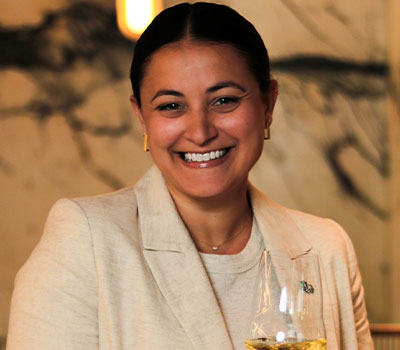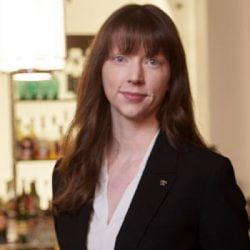Suzanne DeStio has been obsessed with restaurants from a very young age. Whenever her family made the trek from her hometown of Huntington, Long Island, into New York City, her first question was always, “Where are we going to dinner?”
After getting her degree in food science, she decided what she really wanted to do was be a server. She moved into the city and started at Union Square Café’s original location, where the wine director just happened to be building up a sommelier team. DeStio, who had been volunteering in the cellar, was asked to join that team. Though she thought she didn’t know enough, she wanted to learn. When Union Square Café’s original location closed in 2015, DeStio moved to Eleven Madison Park where she became a captain. “It was the first time that every single person at the restaurant was just as excited as me about learning everything they could,” she says. There, she earned her Advanced Sommelier pin, eventually moving to the The Modern as the head sommelier.
After the pandemic, DeStio wanted to get back into restaurants as soon as possible, taking on her first wine director role at One White Street, a multi-story restaurant in New York’s Tribeca neighborhood. The restaurant, which has earned one Michelin star, provides à la carte dining on its first and third floors and an intimate tasting menu on the second, largely driven by the partnership with Rigor Hill Farm in Hudson Valley, the primary source of their produce. —Alissa Bica


What are your favorite wine regions right now?
I always feel connected to a region when I have been there. I got a chance to visit Austria for the VieVinum International Wine Festival in Vienna, and at the end of that I was able to travel to the south to Styria and had a couple of days in that region as well. I had already liked Austrian wines but, like most people, I think I was most comfortable with grüner veltliner, riesling and maybe blaufränkisch. That’s about it—I had studied it for my exams, but I didn’t know a whole ton about it. Having the chance to go there and really see the diversity in how many different grapes thrive there, and how many different styles within each grape there can be, and just the beautiful country and wine community—having that festival and seeing them all together—it was really eye-opening.
At One White Street we have a bunch of wines from Knoll. We have some of the Weingut Tement wines from Steiermark—definitely inspired by my trip. If I had to choose a favorite, it would probably be Prager, because I spoke about one of their bottlings, Wachstum Bodenstein 2016 Smaragd Riesling—that’s how I won Austria’s Best Sommelier competition. So, it’ll always have a special place in my heart.
At The Modern, there was a huge focus on wines from the southern hemisphere. That was brand new for me. I think those regions get a tough rap. When you’re first starting to learn wine, there was a little bit of, “You gotta learn Burgundy and Champagne.” And that’s the most important thing. When you got to Chile, Argentina and South Africa, there was a little bit of, “Just don’t worry about it too much.” You didn’t see those wines on that many wine lists for fine dining restaurants in New York in general. The Modern had a huge emphasis on Australia and South Africa—I definitely fell in love with learning about those wines. South Africa was the most surprising for me. The Sadie Family’s Pofadder [a cinsault from Swartland] is absolutely my favorite wine from South Africa. It’s bright and fresh with crunchy fruits, a little bit peppery, a little bit savory, but crushable at the same time.
And then the third one is probably the new California, like Central Coast… Lodi… I love that new fresh style of wine that’s happening in California and Oregon—some of my favorites are Sandlands, Ceritas wines, Amevive. These wines come from different areas, but they’re all in the same mindset of really well made, delicious wines that you can think a lot about but don’t have to.
Are there areas you focus on most at One White Street?
Our list is more focused on classics at the moment, but we are expanding our wine program dramatically. I probably have about 800 selections on the list; in house, we have about 1,400 wines. Right now, I’d say most of our breadth would be in Burgundy, Rhône, and the third would be a tie between northern and central Italy—Piedmont and Tuscany.
In Burgundy, our team loves selling the wines by Simon Bize and Didier Fornerol. Those are definitely a few producers that I have to say, “Hey, slow down, otherwise we’re gonna be out of it.” Because people just love it and these are really affordable, around 100 to 125 bucks. They just fly off.
The United States is also something I’ve focused on building up. We want our wine program to have something for everyone, whether it’s those juicy, crushable wines that I’m excited about—they can range from eighty to a couple hundred bucks.
The Rhône is where we have some verticals from legendary producers like Chave. The J.L. Chave Saint Joseph—we have the 2018 and 2020—that’s a classic benchmark that goes for 250-dollars a bottle—a great option if you’re going to have our burger. Another favorite of mine is the Hervé Souhaut La Souteronne—it’s a gamay from the outlying regions of the Rhône that’s only 85-dollars.
That’s where I focused last year, but we have a cellar renovation in progress. We literally received a wine rack today that I’m about to go build. Some of those regions, like Austria, are still half a page on the list, which is more than a lot of people can say, but I’m like, “It’s so small and sad right now.” I have 15 to 20 wines to add to the list from Austria once I have the space to put them away. I’m excited now to focus more on the regions that I spoke about that are a little bit lesser represented around the city, like Austria, the newer United States and southern hemisphere.
Are there any other new regions you’ve added to your list?
Portugal is definitely a region that has expanded and continues to expand. It’s another place where I went this past year. I think it also fell into the category of wine regions that a lot of somms didn’t really know much about ten years ago, or maybe we thought there’s only touriga nacional and Port. But learning about the wines of Luís Pato, Luis Seabra and Baías e Enseadas, and learning about some of the other grapes, like castelão and baga, has been unbelievable. Whites like Niepoort Coche Branco from rabigato and arinto is like white Burgundy from Portugal. And the reds can age. The Luís Pato with age—every time you open a bottle you’re like, “Let’s see. The 2008? It’s amazing. Let’s try the 2000. Holy crap, it’s still amazing.” It’s unbelievable how these wines age and I hadn’t even heard of them five years ago. So, even though at the moment my list does have the most Burgundy on it, I’m so much more excited about these other regions. When you have somebody come in and say, “Well, I love Burgundy, but I don’t feel like spending 100 bucks today.” Great. Why don’t you have this 2008, single vineyard wine from old vines from Bairrada in Portugal, and it’s gonna be just as delicious.
Have you seen an uptick in non-alcoholic sales?
We usually have a non-alcoholic, white and red wine, a sparkling apple cider, a couple of fermented pet-nat teas from Spain, which I love. We have non-alcoholic beer and three non-alcoholic cocktails. So yeah, it’s definitely something we focus on, and people do go for it. I don’t really know if it impacts wine sales, because we still sell a lot of wine. And I don’t know if those people would have gotten wine, I think maybe they would have gotten nothing. It’s nice to have available for them to go for in lieu of nothing.
Click here to read more about DeStio’s pairings and One White Street’s tasting menu, ‘A Dinner Party.’
Based in Los Angeles, California, Alissa Bica is the Associate Editor and Spirits Critic at Wine & Spirits. She is also a sommelier at 71 Above and co-runs the home wine tasting company, Côte Brune and Blonde. In any rare moments of free time, she writes about obscure grape varieties in the blog Off the Beaten Wine Path.
This is a W&S web exclusive. Get access to all of our feature stories by signing up today.




















